If I Turn Off the Breaker Should I Be Getting a Reading on My Volt Sensor
How to Apply Cheap Electric Testers
Three testers make electrical work safer and easier — and for less than $twenty, yous tin can own them all.
Introduction
We'll show yous how to utilise inexpensive electric testers to make electrical piece of work safer and easier. We embrace three testers — a not-contact voltage tester, a circuit tester and a continuity tester. You can buy all three at home centers for about $20. Then you'll never have to worry nearly getting shocked again.
Tools Required
A non-contact voltage tester, a circuit tester and a continuity tester — they toll less than $xx birthday at home improvement centers. Here, nosotros explain why that's coin well-spent.
Project pace-by-step (13)
Step 1
How to Test Electric Outlets and How to Test a Light Switch with a Non-Contact Voltage Tester
- This is the safest tool to confirm that electrical power is off, fifty-fifty before you touch a wire.
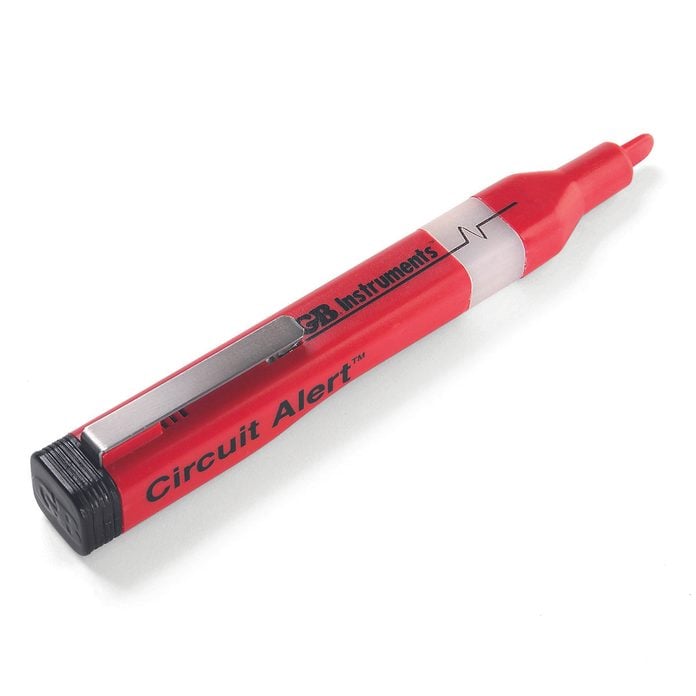
Step ii
Examination the Receptacles
- Test receptacles with an electrical outlet tester to make sure they're off before removing them.
- Turn the ability off to the outlet.
- Shove the electrical outlet tester nose into the narrow (hot) slot of the receptacle.
- Note: The tester will light and chirp continuously if the ability is still on.

Stride 3
Exam for Hot Wires
- Exam for hot wires inside a receptacle.
- Pull out the receptacle.
- Button the electrical outlet tester deep into the box to bank check for other hot wires.
- If y'all observe them, turn them off at the main console.
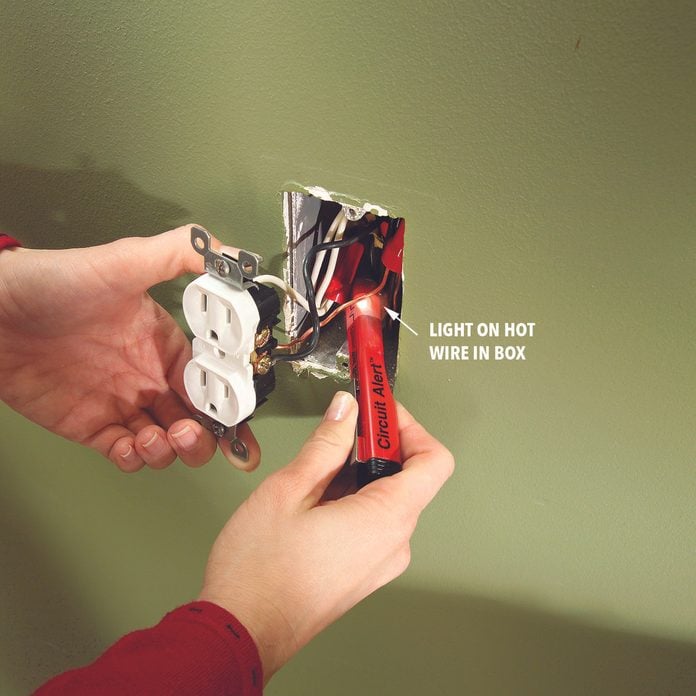
Footstep four
Test Switches
- Test switches to make sure the power is off.
- Turn the power off at the main panel.
- Remove the cover plate.
- Button the tester nose close to i, and then the other, of the two switch wire terminals to see if either wire is still hot.
- If at that place are no live wires, unscrew the switch, pull information technology out and test all other wires in the box.
- If there are multiple switches, check them all.
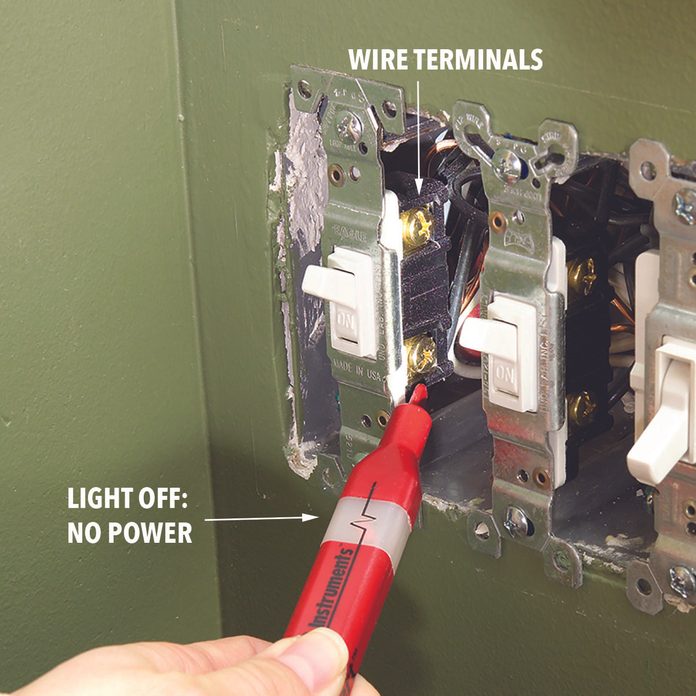
Step 5
Test Calorie-free Fixtures
- Remove the bulb and test the contact in the bottom of the socket for voltage.
- Make sure the low-cal switch is in the 'on' position.
- If no voltage is present, unscrew the fixture from the electrical box.
- Pull it out and exam the other wires in the box every bit before.

Step 6
Examination Cables
- Apply the electric outlet tester to identify hot cables.
- Note: This test method is for plastic-sheathed cables only, so that you tin plough those circuits off earlier sawing or drilling effectually them.
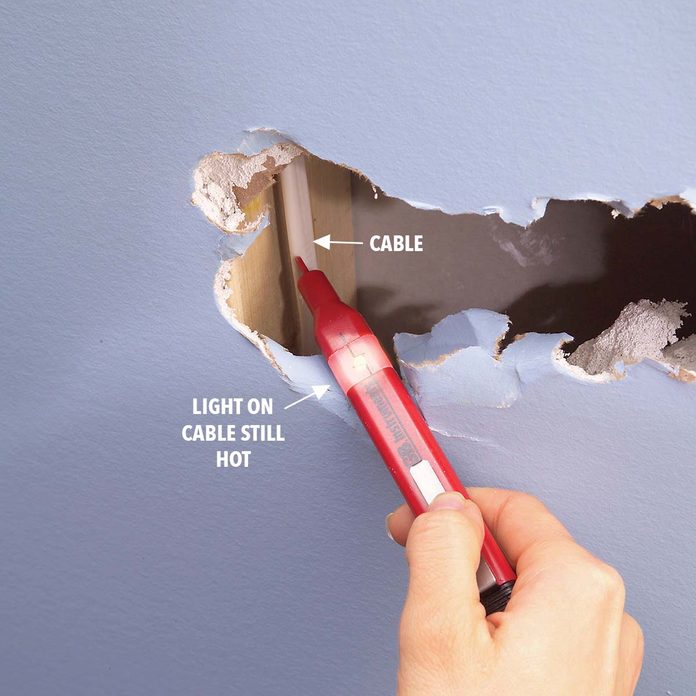
Bank check Your Batteries
This electric outlet tester is powered by minor batteries, so make sure it works before using it. Shove the tip into the slots of a receptacle that'south live, hold it virtually a plugged-in lamp string or hold it against a light bulb that's on. With about testers, you lot'll see a series of flashes and hear continuous chirps that indicate voltage. Testers may flash and chirp at other times, simply without the continuous design that indicates a hot wire.
Step 7
Apply a Circuit Tester to Exam for Practiced Grounding
- This is the most reliable tool to tell if a circuit is complete.
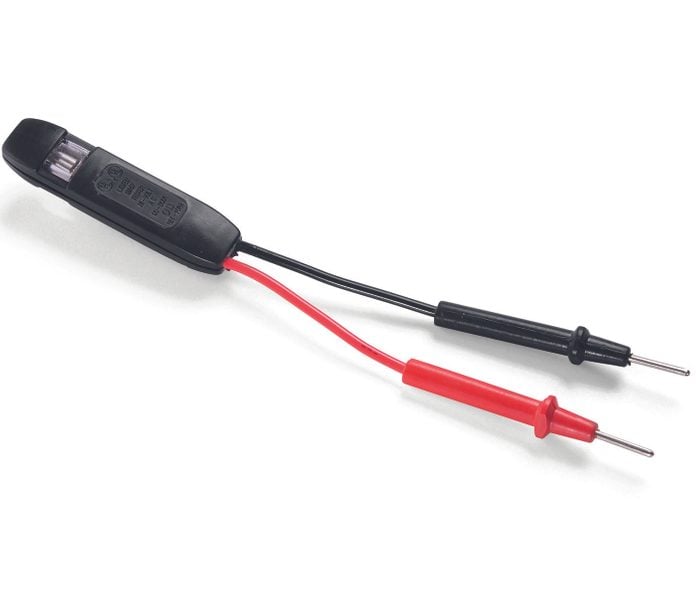
Footstep 8
Test Basis Wires
- Disconnect and separate the wires to a device with the circuit off.
- Plow the circuit dorsum on.
- Bear upon the hot wire with one pb and the ground wire with the other pb.
- Note: The light will come up on if the ground is expert.

Stride 9
Test Metallic Boxes
- Examination whether a metal box is grounded by using the same procedure equally in a higher place.
- Bear on the metal box instead of the footing wire with the 2nd lead.
- Note: If the tester lights up, the box is grounded.
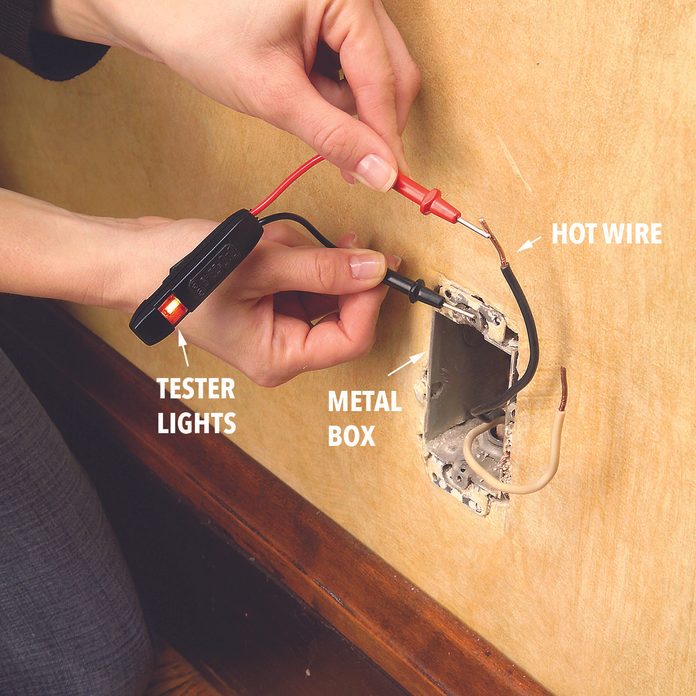
More on Using a Two-Atomic number 82 Excursion Tester
The two-lead circuit tester shown here also tests for voltage. When you touch a live hot wire (black or any other color except light-green and white) with ane lead and a neutral (white) or ground (light-green or bare copper) with the other, the neon test lamp should light. It confirms that the power is on and that you accept a complete (good) circuit. If the lite doesn't come on, either the power is off or you have a bad circuit.
This tool comes in particularly handy in older homes when you desire to know if an equipment ground wire (green insulated or bare copper) is actually continued to footing elsewhere in the organization.
Y'all oftentimes accept to check this when you lot replace older ungrounded switches with grounded ones as at present required by the National Electrical Code. You often find an unused bare ground wire folded back into the box, and you accept to exam it to make sure that it's connected to the residue of the grounding system before hooking up your new switch.
CAUTION: Avoid touching a alive hot wire and don't let information technology touch anything else. Agree the tester leads by the insulated portion while making contact. And turn the circuit off over again every bit soon as y'all cease the exam.
Pace x
Utilize a Continuity Tester to Identify Wires and Test Switches
- This is a safe tool that allows you to trace wiring and examination switches.
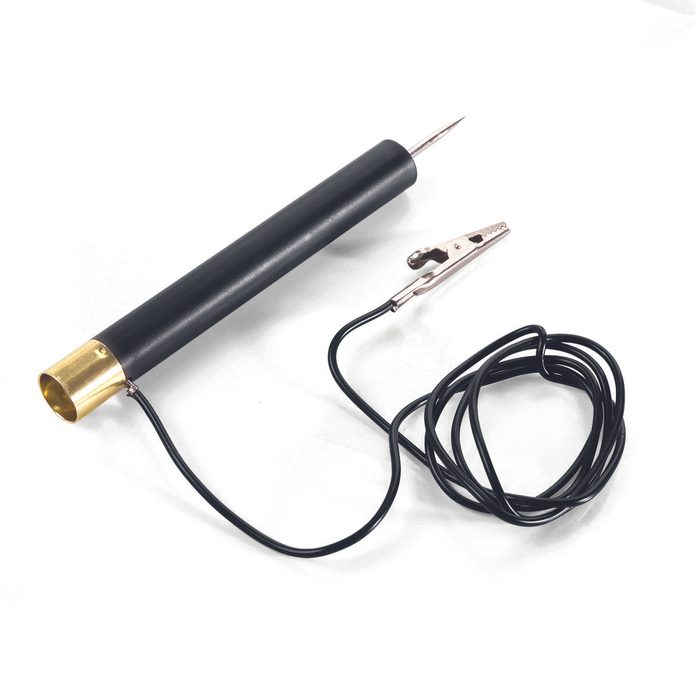
Pace eleven
Identify Remote Wires
- Attach the clip to the wire and probe other wires with the pointed end until the tester lights.
- Note: The electrical ability should be off.
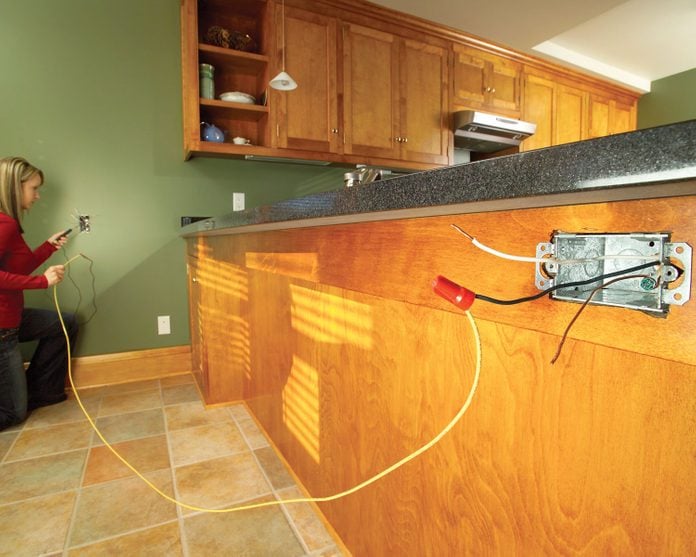
Step 12
Utilise a Test Wire
- Clip the atomic number 82 to the exam wire.
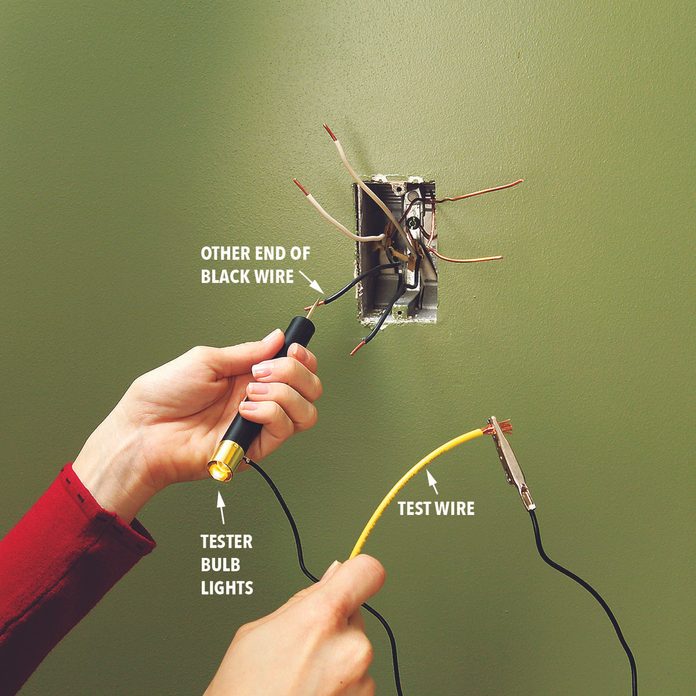
Step 13
Test Switches
- Remove the switch.
- Clip i lead to one switch concluding.
- Bear on the point to the other terminal and flip the switch on and off.
- Note: The tester light will go on and off if the switch is good.
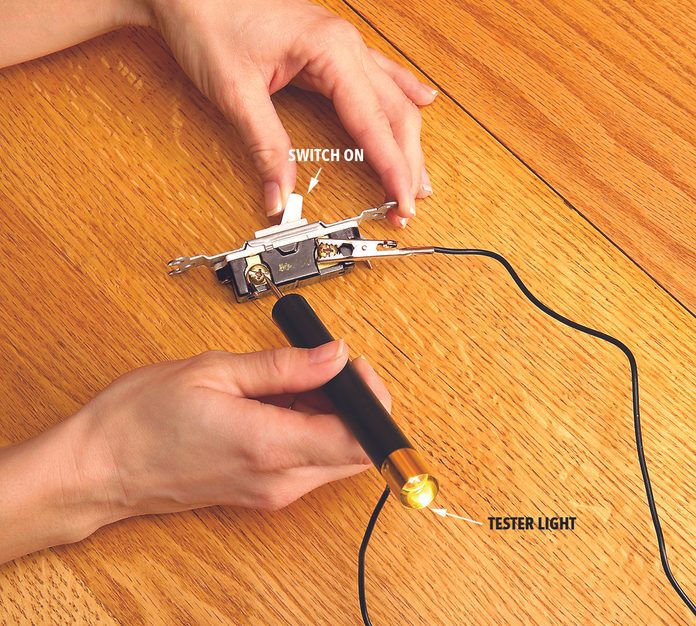
Information technology's hard and dangerous to trace the routes of various wires with circuits turned on. A continuity tester does information technology but and safely with the circuits turned off. It has a probe, which contains a bombardment and a low-cal bulb, and a wire lead. When yous bear on the ends to any continuous conductive path, usually a wire, with both the probe and the lead, a circuit will be complete and the bulb will light. In fact, to test the bulb to brand certain information technology'due south working, but affect the lead to the probe.
Working with several boxes and can't recollect which wire goes where? With the power close off, simply connect a test wire to a circuit wire in ane box, clip the lead to the test wire and touch the probe to the ends of the circuit wires in the other box. The seedling will light when you find the right wire.
Another great apply for the excursion tester is to determine whether a switch is working. Disconnect the switch, connect one lead to one terminal and put the probe on the other while you flick the switch on and off. If the switch is good, the seedling should low-cal up and turn off besides.
Caution: If you take aluminum wiring, don't mess with it. Call in a licensed pro who'south certified to piece of work with information technology. This wiring is dull gray, not the deadening orangish that's feature of copper.
mccarthyyounnoubt.blogspot.com
Source: https://www.familyhandyman.com/project/how-to-use-cheap-electrical-testers/
Belum ada Komentar untuk "If I Turn Off the Breaker Should I Be Getting a Reading on My Volt Sensor"
Posting Komentar